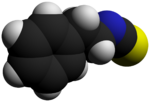Chemistry:Phenethyl isothiocyanate
From HandWiki

| |||
|
| |||
| Names | |||
|---|---|---|---|
| Preferred IUPAC name
(2-Isothiocyanatoethyl)benzene | |||
| Other names
Phenylethyl isothiocyanate; Phenethyl mustard oil
| |||
| Identifiers | |||
3D model (JSmol)
|
|||
| Abbreviations | PEITC | ||
| ChEBI | |||
| ChEMBL | |||
| ChemSpider | |||
PubChem CID
|
|||
| UNII | |||
| |||
| |||
| Properties | |||
| C9H9NS | |||
| Molar mass | 163.24 g·mol−1 | ||
Except where otherwise noted, data are given for materials in their standard state (at 25 °C [77 °F], 100 kPa). | |||
| Infobox references | |||
Tracking categories (test):
Phenethyl isothiocyanate (PEITC) is a naturally occurring isothiocyanate whose precursor, gluconasturtiin is found in some cruciferous vegetables,[1] especially watercress.
PEITC has been studied for its potential for chemoprevention of cancers,[2][3] such as prostate cancer.[4]
In terms of biosynthesis, PEITC is produced from gluconasturtiin by the action of the enzyme myrosinase.
References
- ↑ "Dictionary of Cancer Terms: PEITC". National Cancer Institute. http://www.cancer.gov/dictionary?cdrid=44447.
- ↑ Cheung, KL; Kong, AN (2010). "Molecular targets of dietary phenethyl isothiocyanate and sulforaphane for cancer chemoprevention". The AAPS Journal 12 (1): 87–97. doi:10.1208/s12248-009-9162-8. PMID 20013083.
- ↑ Kwon, Ki Han; Xu, Changjiang; Keum, Young-Sam; Khor, Tin Oo; Kim, Jung-Hwan; Huang, Mou-Tuan; Reddy, Bandaru S.; Li, Wenge et al. (2007). "Natural dietary phytochemicals: a promising future for cancer prevention and treatment of earlier lesion". Cancer: Disease Progression and Chemoprevention: 109–126.
- ↑ Wang, LG; Chiao, JW (2010). "Prostate cancer chemopreventive activity of phenethyl isothiocyanate through epigenetic regulation (review)". International Journal of Oncology 37 (3): 533–9. doi:10.3892/ijo_00000702. PMID 20664922.
 |



